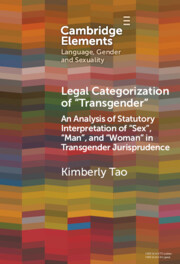Element contents
Legal Categorization of 'Transgender'
Published online by Cambridge University Press: 23 February 2024
Summary
Keywords
- Type
- Element
- Information
- Online ISBN: 9781009221221Publisher: Cambridge University PressPrint publication: 21 March 2024
References
- 1
- Cited by

